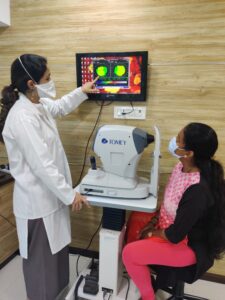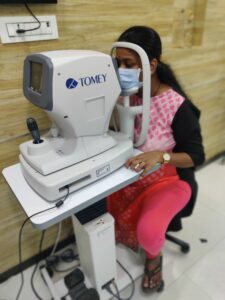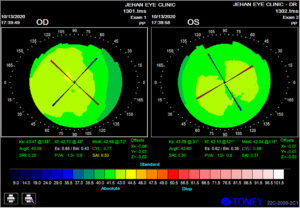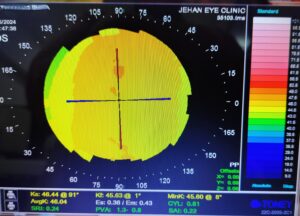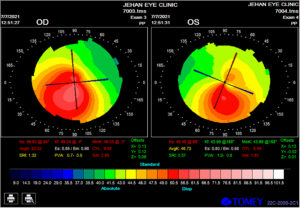Patients of progressive Keratoconus are advised Corneal Collagen Cross Linking
C3R to halt the progression. When progression of Keratoconus is documented, either on
Topography or increase in spectacle powers, this treatment called C3R Surgery or CXL
needs to be done.
Corneal Collagen Cross-linking with Riboflavin (C3R Surgery) has been demonstrated in
Europe to strengthen a weakened corneal structure. Corneal Collagen Cross Linking is
done with Riboflavin, which is a vitamin solution used to soak the cornea and then
exposed under Ultraviolet- A light. This photochemical reaction increases the linkage
between the collagen fibres of these weak corneas. This treatment has been shown to halt
the progression of the condition, though not reverse it.
Once the procedure is done, the cornea stabilizes over a period of 2-3 months, after
which the patient will be re-evaluated for need of glasses or contact lenses.
This is a relatively new procedure done for Keratoconus patients who have a
small spectacle number and good corneal thickness. Here a specialized laser is first
used to minimize the number, and then the regular cross linking is performed. It can
only be done for a select few cases, and still the patient may require glasses or lenses
even after the procedure.
It is important for the patient to know that this laser will only regularize and maybe
reduce the spectacle power, but will never give precise outcomes like that in LASIK
because the cornea is irregular to begin with.
What is the purpose of CXL / C3R surgery?
The C3R / CXL surgery is a procedure which is
done to halt further progress of the corneal bulge which is caused due to a
disorder called Keratoconus.
How does CXL / C3R surgery work?
CXL / C3R surgery causes the
collagen strands in the eye to stiffen and get crosslinked and re-attached to
each other, thus making the cornea stronger and more stable which in turn
credibly halts the progression of the disease.
How long does CXL / C3R surgery take?
The CXL / C3R surgery takes
approximately 30 minutes to 1 hour for each eye. (based on different types of
machines). The procedure is done by using anesthetic eye drops (also known as
topical anesthesia). Riboflavin eye drops are used to soak the cornea, this
takes 20-30 minutes and then the eye is exposed to UVA light.
Who is a candidate for CXL / C3R surgery?
Patients who suffer from
progressive Keratoconus are the ideal candidates the CXL / C3R surgery.
Is CXL / C3R surgery a permanent solution for eye
conditions, or will additional treatments be required in the future?
The CXL / C3R surgery is a first
line of treatment for keratoconus and it is the only approach to halt the
progression of keratoconus.
How successful is CXL / C3R surgery in halting the
progression of eye conditions like keratoconus?
Most patients require the
procedure only once in their life. Rarely the condition may worsen in patients
with severe eye allergies/ eye rubbing, and they may require a repeat procedure.
Nonetheless regular follow up visits must be done by your doctor.
Are there any specific pre-operative instructions to
follow for undergoing CXL / C3R surgery?
Certain pre-operative
instructions must be followed before undergoing the CXL/ C3R surgery, they are
as follows:
Make sure to have someone to accompany and take you home on the day of your
procedure.
Consume a light meal and keep yourself hydrated with fluids on the day of your
procedure.
Do not wear any eye makeup, cologne or perfume on the day of your procedure.
Do not plan on going for a vacation, flying or swimming for a week or two after
your procedure.
Limit your sun exposure for the first 2 months after your procedure
How long until I can resume my normal activities?
After the C3R / CXL surgery
patients can mostly resume their normal activities within just a few days to an
entire week. It all depends on their recovery/healing rate and the nature of
their profession.
Is there any ongoing research or advancements in CXL
/ C3R surgery that may further improve its effectiveness?
Laser based Cross Linking is a
procedure where a laser is done to reshape the excessively conical cornea and
make it less steep, to improve visual outcome along with stabilization of the
cornea.
This does not remove the spectacle number, but will help improve basic vision of
the patient , with and without glasses.
Due to newer developments in technology, we now have various riboflavin
formulations and the capability to deliver higher fluency procedures with
customized treatment patterns.
Are there any lifestyle changes or habits that I
should adopt or avoid before and after CXL / C3R surgery to ensure the best
results?
AVOID EYE RUBBING
Certain instructions have to be followed before and after the CXL/ C3R surgery
they are as follows:
Consume a light meal and keep yourself hydrated with fluids on the day of your
procedure.
Do not wear any eye makeup, cologne or perfume on the day of your procedure.
Post the C3R / CXL surgery, a soft 'bandage' contact lens is put in place for
seven days. Numerous different drops and painkiller tablets have been prescribed
to you. It is vital to keep your eyes lubricated with your eye drops to allow
the surface of the eye to recuperate during the weeks after procedure.
Does insurance cover CXL/ C3R treatment?
YES. It is a medical condition
which needs treatment and hence is eligible for treatment. Check with your
insurance company for more details.
How much does a CXL / C3R treatment cost in India?
The C3R / CXL surgery expenses
can vary based on the medical facility and type of procedure. You can expect the
cost to range from Rs. 30,000 to 70,000 and additional costs if combined with
the laser treatment. It is depending on numerous aspects like surgeon fees,
anesthetist, hospital charges, laser charges and more.
